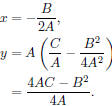Math 165 Linear Price - Demand Model and Parabolas
A typical problem about maximizing revenue
A manufacturer determines that when x hundred units of a particular commodity
are
produced, they can all be sold for a unit price given by the demand function p =
80 - x
dollars. What is the maximum revenue (in dollars)?
The demand function is linear - the quantity (demand) x and the price p are
related by
a linear relation. The problem is to set the price p (or demand x) so that the
revenue R,
R = p · x hundred dollars
is maximized.
Notice that
R = (80 - x)x
is a quadratic function of x; moreover, the coefficient of x2 is
negative, so the graph of
R(x) is a parabola opening downward. We even have that the parabola is presented
in a
factored form with roots at x = 0 and x = 80.
If we graph the parabola, it appears that R is maximized at the vertex of the
parabola
which occurs when x = 40, halfway between the roots!
We are already familiar with the quadratic formula for the roots of the equation
Ax2 + Bx + C = 0
occur at

with the usual remarks about the case B2 - 4AC ≤ 0.
The quadratic formula is very much related to the process called completing the
square -
write

It is apparent that the vertex of the parabola is located at

If A > 0, the graph opens upward and the quadratic
function has a minimum value at
the vertex.
If A < 0, the graph opens downward and the quadratic function has a maximum
value
at the vertex.
In our example A = -1, B = 80, C = 0. The revenue is maximized when
x = -B/2A = 40(hundred units);
p = (80 - 40) dollars;



